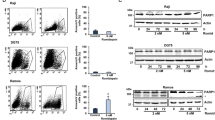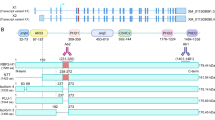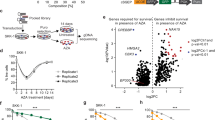Abstract
The t(8;21) chromosomal translocation that generates the fusion oncoprotein RUNX1-ETO predominates in leukemia patients of the French-American-British (FAB) class M2 subtype. The oncoprotein has the capacity to promote expansion of hematopoietic stem/progenitor cells and induces leukemia in association with other genetic alterations. Here, we show that RUNX1-ETO undergoes degradation in response to treatment with histone deacetylase inhibitors, one of which, depsipeptide (DEP), is currently undergoing phase II clinical testing in a variety of malignancies. These compounds induce turnover of RUNX1-ETO without affecting the stability of RUNX1-ETO partner proteins. In addition, RUNX1-ETO physically interacts with heat shock protein 90 (HSP90). DEP treatment interrupts the association of RUNX1-ETO with HSP90 and induces proteasomal degradation of RUNX1-ETO. DEP and the HSP90 antagonist 17-allylamino-geldanamycin (17-AAG) both triggered RUNX1-ETO degradation, but without any additive or cooperative effects. These findings may stimulate the development of more rational and effective approaches for treating t(8;21) patients using histone deacetylase inhibitors or HSP90 inhibitors.
This is a preview of subscription content, access via your institution
Access options
Subscribe to this journal
Receive 50 print issues and online access
$259.00 per year
only $5.18 per issue
Buy this article
- Purchase on Springer Link
- Instant access to full article PDF
Prices may be subject to local taxes which are calculated during checkout








Similar content being viewed by others
References
Amann JM, Nip J, Strom DK, Lutterbach B, Harada H, Lenny N et al. (2001). Mol Cell Biol 21: 6470–6483.
Aoyagi S, Archer TK . (2005). Trends Cell Biol 15: 565–567.
Bali P, Pranpat M, Bradner J, Balasis M, Fiskus W, Guo F et al. (2005). J Biol Chem 280: 26729–26734.
Bereshchenko OR, Gu W, Dalla-Favera R . (2002). Nat Genet 32: 606–613.
Blagosklonny MV, Robey R, Sackett DL, Du L, Traganos F, Darzynkiewicz Z et al. (2002). Mol Cancer Ther 1: 937–941.
Byrd JC, Marcucci G, Parthun MR, Xiao JJ, Klisovic RB, Moran M et al. (2005). Blood 105: 959–967.
Chen GQ, Shi XG, Tang W, Xiong SM, Zhu J, Cai X et al. (1997). Blood 89: 3345–3353.
de Guzman CG, Warren AJ, Zhang Z, Gartland L, Erickson P, Drabkin H et al. (2002). Mol Cell Biol 22: 5506–5517.
Druker BJ . (2002). Oncogene 21: 8541–8546.
Druker BJ, Tamura S, Buchdunger E, Ohno S, Segal GM, Fanning S et al. (1996). Nat Med 2: 561–566.
Drummond DC, Noble CO, Kirpotin DB, Guo Z, Scott GK, Benz CC . (2005). Annu Rev Pharmacol Toxicol 45: 495–528.
Felsher DW, Bishop JM . (1999). Mol Cell 4: 199–207.
Fenske TS, Pengue G, Mathews V, Hanson PT, Hamm SE, Riaz N et al. (2004). Proc Natl Acad Sci USA 101: 15184–15189.
Fuino L, Bali P, Wittmann S, Donapaty S, Guo F, Yamaguchi H et al. (2003). Mol Cancer Ther 2: 971–984.
Garrido SM, Appelbaum FR, Willman CL, Banker DE . (2001). Exp Hematol 29: 448–457.
Gelmetti V, Zhang J, Fanelli M, Minucci S, Pelicci PG, Lazar MA . (1998). Mol Cell Biol 18: 7185–7191.
George P, Bali P, Annavarapu S, Scuto A, Fiskus W, Guo F et al. (2005). Blood 105: 1768–1776.
Hake SB, Xiao A, Allis CD . (2004). Br J Cancer 90: 761–769.
Heidenreich O, Krauter J, Riehle H, Hadwiger P, John M, Heil G et al. (2003). Blood 101: 3157–3163.
Higuchi M, O'Brien D, Kumaravelu P, Lenny N, Yeoh E-J, Downing J . (2002). Cancer Cell 1: 63–74.
Hildebrand D, Tiefenbach J, Heinzel T, Grez M, Maurer AB . (2001). J Biol Chem 276: 9889–9895.
Huang ME, Ye YC, Chen SR, Chai JR, Lu JX, Zhoa L et al. (1988). Blood 72: 567–572.
Huettner CS, Zhang P, Van Etten RA, Tenen DG . (2000). Nat Genet 24: 57–60.
Insinga A, Monestiroli S, Ronzoni S, Gelmetti V, Marchesi F, Viale A et al. (2005). Nat Med 11: 71–76.
Jenuwein T, Allis CD . (2001). Science 293: 1074–1080.
Jin YH, Jeon EJ, Li QL, Lee YH, Choi JK, Kim WJ et al. (2004). J Biol Chem 279: 29409–29417.
Johnstone RW . (2002). Nat Rev Drug Discov 1: 287–299.
Johnstone RW, Licht JD . (2003). Cancer Cell 4: 13–18.
Kasashima K, Sakota E, Kozu T . (2004). Biochimie 86: 713–721.
Klisovic MI, Maghraby EA, Parthun MR, Guimond M, Sklenar AR, Whitman SP et al. (2003). Leukemia 17: 350–358.
Komori A, Sueoka E, Fujiki H, Ishii M, Kozu T . (1999). Jpn J Cancer Res 90: 60–68.
Kovacs JJ, Murphy PJ, Gaillard S, Zhao X, Wu JT, Nicchitta CV et al. (2005). Mol Cell 18: 601–607.
Kozu T, Sugio Y, Fukuyama T, Sueoka E, Otsuka T, Akagi K . (2000). Genes Cells 5: 637–647.
Linggi B, Muller-Tidow C, van de Locht L, Hu M, Nip J, Serve H et al. (2002). Nat Med 8: 743–750.
Linggi BE, Brandt SJ, Sun ZW, Hiebert SW . (2005). J Cell Biochem 96: 938–950.
Lutterbach B, Westendorf JJ, Linggi B, Patten A, Moniwa M, Davie JR et al. (1998). Mol Cell Biol 18: 7176–7184.
Marks PA, Richon VM, Miller T, Kelly WK . (2004). Adv Cancer Res 91: 137–168.
Marshall JL, Rizvi N, Kauh J, Dahut W, Figuera M, Kang MH et al. (2002). J Exp Ther Oncol 2: 325–332.
Matsushita H, Kobayashi H, Mori S, Kizaki M, Ikeda Y . (1995). Biochem Biophys Res Commun 215: 431–437.
Muller S, Miller Jr WH, Dejean A . (1998). Blood 92: 4308–4316.
Nakajima H, Kim YB, Terano H, Yoshida M, Horinouchi S . (1998). Exp Cell Res 241: 126–133.
Odenike O, Alkan S, Sher D, Godwin J, Huo D, Myers M et al. (2004). Blood 104: 264.
Okuda T, Cai Z, Yang S, Lenny N, Lyu C, van Deursen J et al. (1998). Blood 91: 3134–3143.
Pabst T, Mueller BU, Harakawa N, Schoch C, Haferlach T, Behre G et al. (2001). Nat Med 7: 444–451.
Pichardo DA, Querfeld C, Guitart J, Kuzel TM, Rosen ST . (2004). Leuk Lymphoma 45: 1755–1765.
Piekarz R, Bates S . (2004). Curr Pharm Des 10: 2289–2298.
Piekarz RL, Robey R, Sandor V, Bakke S, Wilson WH, Dahmoush L et al. (2001). Blood 98: 2865–2868.
Piekarz RL, Robey RW, Zhan Z, Kayastha G, Sayah A, Abdeldaim AH et al. (2004). Blood 103: 4636–4643.
Prodromou C, Pearl LH . (2003). Curr Cancer Drug Targets 3: 301–323.
Raelson JV, Nervi C, Rosenauer A, Benedetti L, Monczak Y, Pearson M et al. (1996). Blood 88: 2826–2832.
Sakakura C, Yamaguchi-Iwai Y, Satake M, Bae SC, Takahashi A, Ogawa E et al. (1994). Proc Natl Acad Sci USA 91: 11723–11727.
Sandor V, Bakke S, Robey RW, Kang MH, Blagosklonny MV, Bender J et al. (2002). Clin Cancer Res 8: 662–664.
Sandor V, Senderowicz A, Mertins S, Sackett D, Sausville E, Blagosklonny MV et al. (2000). Br J Cancer 83: 817–825.
Sato N, Ohta T, Kitagawa H, Kayahara M, Ninomiya I, Fushida S et al. (2004). Int J Oncol 24: 679–685.
Shao W, Fanelli M, Ferrara FF, Riccioni R, Rosenauer A, Davison K et al. (1998). J Natl Cancer Inst 90: 124–133.
Sun ZW, Allis CD . (2002). Nature 418: 104–108.
Sutheesophon K, Nishimura N, Kobayashi Y, Furukawa Y, Kawano M, Itoh K et al. (2005). J Cell Physiol 203: 387–397.
Szyrach M, Munchberg FE, Riehle H, Nordheim A, Krauter J, Nagel S et al. (2001). Eur J Biochem 268: 3550–3557.
Tabe Y, Konopleva M, Contractor R, Munsell M, Schober WD, Jin L et al. (2005). Blood 107: 1546–1554.
Vanhaecke T, Papeleu P, Elaut G, Rogiers V . (2004). Curr Med Chem 11: 1629–1643.
Wang J, Hoshino T, Redner RL, Kajigaya S, Liu JM . (1998). Proc Natl Acad Sci USA 95: 10860–10865.
Wang J, Saunthararajah Y, Redner RL, Liu JM . (1999). Cancer Res 59: 2766–2769.
Yamaguchi Y, Imai Y, Izutsu K, Asai T, Ichikawa M, Yamamoto G et al. (2004). J Biol Chem 279: 15630–15638.
Yan M, Burel SA, Peterson LF, Kanbe E, Iwasaki H, Boyapati A et al. (2004). Proc Natl Acad Sci USA 101: 17186–17191.
Yang G, Khalaf W, van de Locht L, Jansen JH, Gao M, Thompson MA et al. (2005). Mol Cell Biol 25: 5869–5879.
Yoshida H, Kitamura K, Tanaka K, Omura S, Miyazaki T, Hachiya T et al. (1996). Cancer Res 56: 2945–2948.
Yuan Y, Zhou L, Miyamoto T, Iwasaki H, Harakawa N, Hetherington CJ et al. (2001). Proc Natl Acad Sci USA 98: 10398–10403.
Zhu J, Koken MH, Quignon F, Chelbi-Alix MK, Degos L, Wang ZY et al. (1997). Proc Natl Acad Sci USA 94: 3978–3983.
Acknowledgements
We thank the members of the Hiebert lab for helpful discussions and encouragement, the Vanderbilt-Ingram Cancer Center (CA68485) for support and the use of shared resources, and Dr John Wright for assistance in procuring depsipeptide. This work was supported by National Institutes of Health (NIH) grants RO1-CA64140 (SWH) and R01-HL49118 and a VA Merit Review Award (SJB).
Author information
Authors and Affiliations
Corresponding author
Rights and permissions
About this article
Cite this article
Yang, G., Thompson, M., Brandt, S. et al. Histone deacetylase inhibitors induce the degradation of the t(8;21) fusion oncoprotein. Oncogene 26, 91–101 (2007). https://doi.org/10.1038/sj.onc.1209760
Received:
Revised:
Accepted:
Published:
Issue Date:
DOI: https://doi.org/10.1038/sj.onc.1209760
Keywords
This article is cited by
-
SIAH proteins: critical roles in leukemogenesis
Leukemia (2013)
-
AML1-ETO targets and suppresses cathepsin G, a serine protease, which is able to degrade AML1-ETO in t(8;21) acute myeloid leukemia
Oncogene (2013)
-
AML1-ETO driven acute leukemia: insights into pathogenesis and potential therapeutic approaches
Frontiers of Medicine (2012)
-
The HDAC class I-specific inhibitor entinostat (MS-275) effectively relieves epigenetic silencing of the LAT2 gene mediated by AML1/ETO
Oncogene (2011)
-
Leukaemogenesis: more than mutant genes
Nature Reviews Cancer (2010)



